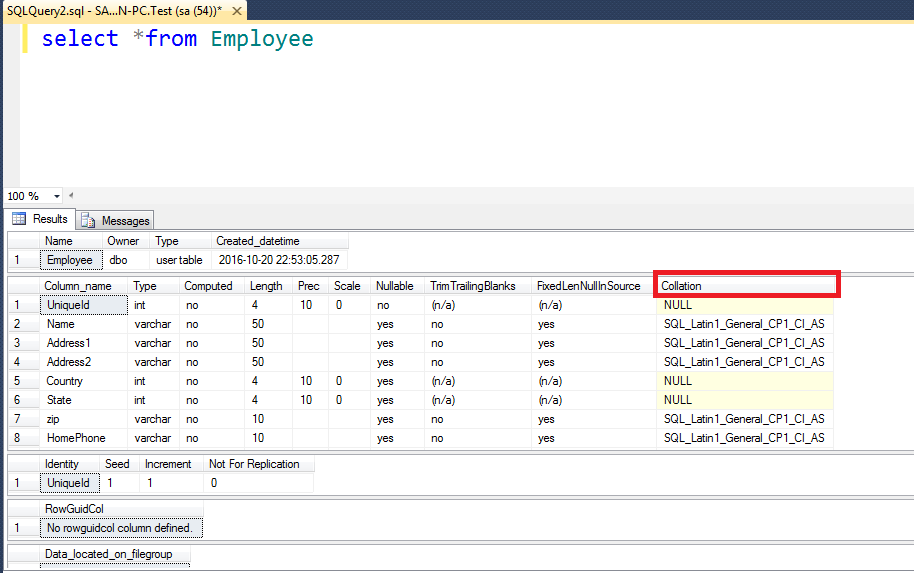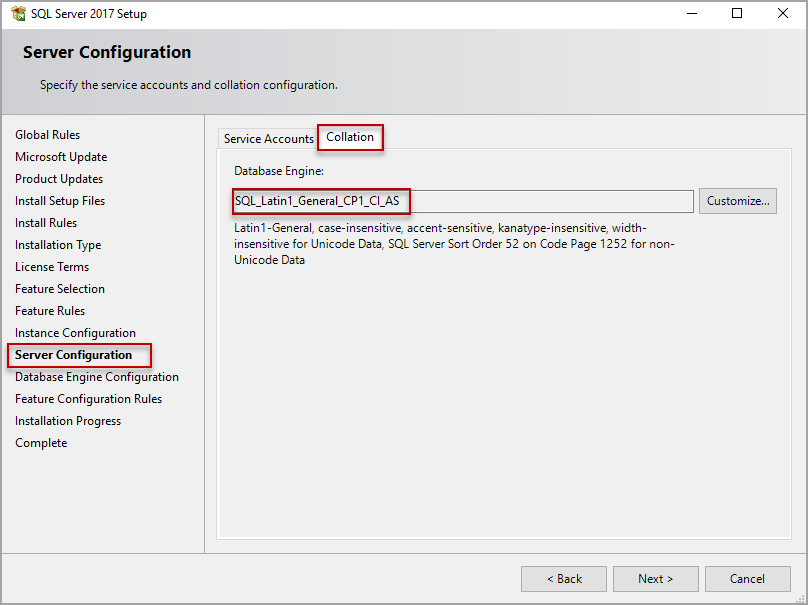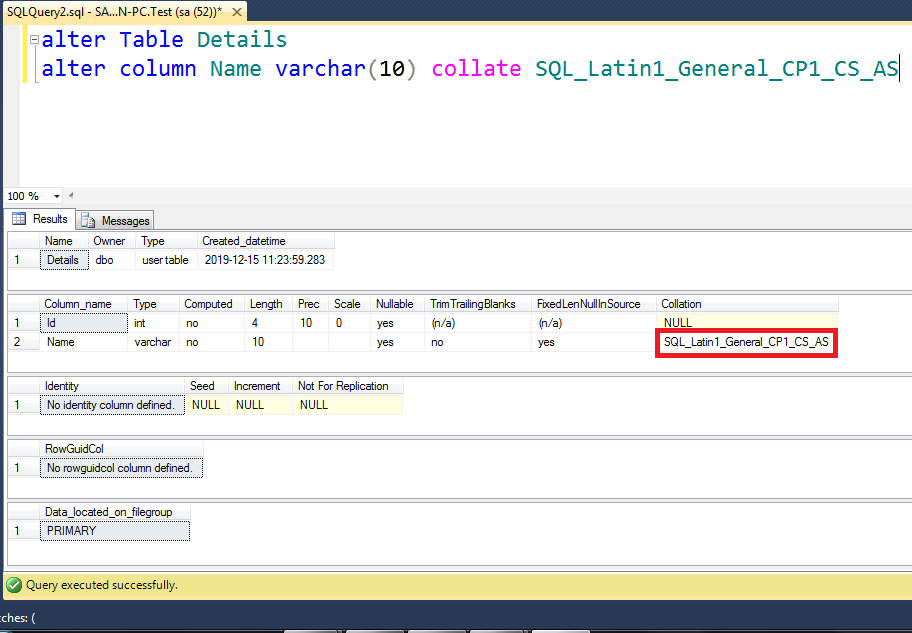Collate SQL, the unsung hero of database management, plays a pivotal role in ensuring data consistency and accuracy. This intricate mechanism governs how your database sorts, compares, and validates text data, influencing everything from search results to data integrity.
From understanding the nuances of case sensitivity and accent sensitivity to navigating the complexities of internationalization and data migration, this comprehensive guide delves into the world of collations, providing insights that empower you to optimize your SQL database for performance, security, and scalability.
Collation Settings and Database Compatibility
Collation settings play a crucial role in database management, defining the rules for comparing and sorting character data. They influence how data is stored, retrieved, and manipulated, impacting various database operations. Understanding collations and their impact on database compatibility is essential for maintaining data integrity and ensuring seamless integration across different systems.
Setting Collations
Collations can be defined at different levels within a database system, allowing for granular control over data comparison and sorting behavior.
- Database Level: The default collation for a database is set during its creation. All tables and columns within the database will inherit this collation unless explicitly overridden.
- Table Level: Collations can be specified for individual tables, overriding the database-level setting. This allows for different sorting and comparison rules for specific tables.
- Column Level: The most granular level of collation control is at the column level. By defining a collation for a specific column, you can customize the comparison and sorting behavior for that particular data field.
The syntax for setting collations varies depending on the specific database system. Here are examples for common SQL databases:
MySQL
CREATE DATABASE my_database CHARACTER SET utf8mb4 COLLATE utf8mb4_unicode_ci;
CREATE TABLE my_table (
id INT PRIMARY KEY,
name VARCHAR(255) COLLATE utf8mb4_general_ci
);
PostgreSQL
CREATE DATABASE my_database WITH ENCODING 'UTF8' LC_COLLATE='en_US.utf8' LC_CTYPE='en_US.utf8';
CREATE TABLE my_table (
id SERIAL PRIMARY KEY,
name VARCHAR(255) COLLATE "en_US.utf8"
);
SQL Server
CREATE DATABASE my_database COLLATE SQL_Latin1_General_CP1_CI_AS;
CREATE TABLE my_table (
id INT PRIMARY KEY,
name VARCHAR(255) COLLATE SQL_Latin1_General_CP1_CI_AS
);
Collation Compatibility Across Databases
Different database systems employ distinct collation systems, potentially leading to compatibility issues when exchanging data or integrating databases. For instance, a string sorted in MySQL using a case-insensitive collation might be sorted differently in SQL Server using a case-sensitive collation.
- Character Set: Database systems use character sets to represent characters. Inconsistent character sets can lead to data corruption or display issues when data is transferred between systems.
- Collation Rules: The rules governing character comparison and sorting, such as case sensitivity, accent sensitivity, and character ordering, can vary across databases. This can result in inconsistent data sorting and comparison results.
- Data Conversion: Converting data between databases with different collations can be complex and potentially introduce errors. Proper data conversion procedures are crucial to ensure data integrity.
Collation Issues in Distributed Database Environments
When working with distributed databases, inconsistencies in collation settings can pose significant challenges.
- Data Synchronization: Synchronizing data across databases with different collations can lead to data inconsistencies and conflicts. Data may be sorted differently, resulting in unexpected outcomes.
- Data Comparison: Comparing data across databases with different collations can produce inaccurate results. This can impact queries, joins, and other data manipulation operations.
- Data Validation: Validating data across databases with different collations can be challenging, as the validation rules may differ. This can lead to data integrity issues and data inconsistencies.
Collation Impact on Data Integrity: Collate Sql

Collations play a crucial role in ensuring data integrity within a database. They influence how data is stored, compared, and sorted, ultimately impacting the reliability and consistency of your database operations. Understanding the implications of collations on data integrity is essential for maintaining accurate and trustworthy data.
Data Validation and Uniqueness Constraints
Collations directly affect data validation and uniqueness constraints. When defining constraints, the chosen collation determines how data is compared for uniqueness. For example, if you define a unique constraint on a column using a case-insensitive collation, duplicate values with different case variations will be allowed. Conversely, a case-sensitive collation will enforce strict uniqueness, rejecting any duplicate values regardless of case.
For instance, with a case-insensitive collation, “Apple” and “apple” would be considered identical, while a case-sensitive collation would treat them as distinct values.
This distinction is critical for ensuring the integrity of your data, as it directly influences the validity of your uniqueness constraints.
Impact on Joins and Data Merging
Using incompatible collations during joins and data merging operations can lead to unexpected and potentially erroneous results. When tables with different collations are joined, the comparison of data may yield inaccurate results. For instance, joining two tables with different case-sensitive settings can result in mismatched rows due to case variations in the joining columns.
Consider two tables, one with a case-sensitive collation and the other with a case-insensitive collation. Joining these tables on a column containing “Apple” in the case-sensitive table and “apple” in the case-insensitive table would fail to match the rows due to the case difference.
This discrepancy can lead to inaccurate data analysis and decision-making, highlighting the importance of consistent collation usage across related tables.
Best Practices for Selecting and Managing Collations
To ensure data integrity, adhere to these best practices when selecting and managing collations:
- Consistent Collation Selection: Choose a consistent collation for all tables within a database or schema. This ensures uniform data comparison and sorting, preventing inconsistencies and data integrity issues.
- Case-Sensitive Collation for Sensitive Data: For data where case sensitivity is crucial, such as usernames, passwords, or unique identifiers, utilize a case-sensitive collation to enforce strict uniqueness and prevent unintended data duplication.
- Collation Compatibility: Ensure that all tables involved in joins or data merging operations share the same collation. This guarantees accurate data comparison and prevents inconsistencies that can lead to data integrity violations.
- Collation Awareness: Be mindful of the collation settings used for various database operations, such as data validation, sorting, indexing, and data merging. This awareness helps prevent unexpected outcomes and maintain data integrity.
Collation and Performance

Collation plays a significant role in SQL Server’s performance, particularly when dealing with string operations. Different collations can affect the efficiency of queries, especially those involving sorting, comparisons, and indexing. Understanding how collation impacts performance is crucial for optimizing query execution and achieving optimal database performance.
Performance Implications of Collations
The performance implications of different collations on queries involving string operations are multifaceted. Here’s a breakdown:
- Case-Sensitivity: Case-sensitive collations require additional processing to compare strings, which can lead to slower query execution. For example, queries involving comparisons like ‘John’ = ‘john’ would require extra steps in case-sensitive collations.
- Accent Sensitivity: Collations that are accent-sensitive also require additional processing to compare strings. This is because they need to consider the presence or absence of accents in characters. For instance, comparing ‘café’ and ‘cafe’ would involve extra steps in accent-sensitive collations.
- Character Set: The character set used by a collation influences the size of the data being stored and processed. Using a character set that supports a wider range of characters can lead to larger data sizes, potentially impacting performance.
Collation Impact on Index Usage
Collations can significantly impact the effectiveness of indexes in SQL Server. Indexes are used to speed up data retrieval by providing a sorted structure for data. When a query uses a predicate that involves a string comparison, SQL Server can use an index to quickly locate the relevant data. However, if the collation used for the index and the data being compared differs, the index might not be used effectively. This can lead to slower query execution, as SQL Server might need to perform a full table scan instead of using the index.
For instance, consider a table with a column ‘Name’ indexed using a case-sensitive collation. If a query uses a case-insensitive predicate like ‘WHERE Name = ‘john”, SQL Server might not be able to use the index, resulting in a slower query execution.
Choosing the Optimal Collation for Performance, Collate sql
Choosing the optimal collation for improving query performance requires careful consideration of several factors:
- Data Characteristics: Analyze the data being stored to determine if case sensitivity, accent sensitivity, or specific character sets are necessary. If the data primarily consists of alphanumeric characters without accents, a case-insensitive and accent-insensitive collation might be suitable.
- Query Patterns: Consider the types of queries that will be executed against the database. If the queries frequently involve string comparisons, choosing a collation that aligns with the comparison criteria can improve performance.
- Performance Benchmarks: Perform benchmarks with different collation options to measure their impact on query performance. This can help identify the best collation for your specific workload.
Collation and Internationalization
In the globalized world, applications often need to handle data from diverse sources, including different languages and character sets. This presents challenges for databases, which need to store and process this data accurately and efficiently. Collations play a crucial role in addressing these challenges by providing a framework for handling character sorting, comparison, and data integrity in a multilingual environment.
Collation Support for Internationalization
Collations enable databases to manage data from various languages and regions by defining the rules for comparing and sorting characters. This support for internationalization and localization ensures that applications can handle data consistently across different cultures and languages.
Collations define the rules for comparing and sorting characters in a database, allowing applications to handle data from various languages and regions consistently.
- Character Set Support: Collations specify the character sets used to represent data, allowing databases to store and process characters from different alphabets, including Latin, Cyrillic, Greek, Arabic, and Asian languages.
- Sorting Order: Collations define the sorting order for characters within a language, ensuring that data is sorted according to the specific linguistic rules of the target language.
- Case Sensitivity: Collations can specify whether character comparisons should be case-sensitive or case-insensitive, enabling applications to handle data according to the specific requirements of the target language.
- Accent Sensitivity: Collations can define whether comparisons should consider accents or diacritics, ensuring that data is sorted and compared accurately according to the linguistic rules of the target language.
Examples of Collation Usage
Let’s examine how collations handle character sorting and comparison in different languages:
- English: For English, the default collation typically sorts characters in alphabetical order (A-Z) and ignores case sensitivity. However, some applications might require case-sensitive comparisons for specific purposes.
- French: French uses accented characters like é, è, and à. A French collation would define the sorting order for these accented characters, ensuring that they are sorted correctly according to French linguistic rules.
- Japanese: Japanese uses a combination of characters from different writing systems, including Hiragana, Katakana, and Kanji. A Japanese collation would define the sorting order for these characters, ensuring that they are sorted correctly according to Japanese linguistic rules.
- Arabic: Arabic uses a right-to-left writing system, and its characters can be connected in different ways depending on their position within a word. An Arabic collation would define the sorting order for these characters, taking into account the directionality and connection rules of the Arabic language.
Collation and Security

Collations can play a significant role in data security and access control. While primarily designed for sorting and comparing data, collation settings can inadvertently introduce vulnerabilities that could be exploited by malicious actors. Understanding these vulnerabilities and implementing best practices is crucial to ensure data integrity and prevent unauthorized access.
Vulnerabilities Related to Collation Settings
Collation settings can create vulnerabilities that can be exploited by attackers. These vulnerabilities arise from the way collations handle character comparisons, which can lead to unintended consequences:
- Case-insensitive Collations: When using case-insensitive collations, attackers can exploit the fact that the database does not differentiate between uppercase and lowercase characters. This allows them to bypass security measures that rely on case-sensitivity. For example, an attacker could try to access a user account by entering the username in lowercase, even if the actual username is stored in uppercase.
- Unicode Collations: Unicode collations, while offering support for a wide range of characters, can introduce vulnerabilities if not properly configured. Attackers might exploit inconsistencies in character ordering or sorting rules to bypass security checks or manipulate data.
- Collation Mismatches: When different parts of a system use different collations, it can lead to unexpected behavior and security risks. For instance, if a database uses a case-insensitive collation, while the application uses a case-sensitive collation, it could allow attackers to exploit the difference in character comparisons.
Security Best Practices for Collations
Here are some best practices for choosing and managing collations to enhance data security:
- Use Case-Sensitive Collations: Whenever possible, use case-sensitive collations to prevent attackers from exploiting case-insensitive comparisons.
- Choose Appropriate Unicode Collations: Select Unicode collations that are compatible with the data you are storing and ensure that the chosen collation is consistent across the entire system.
- Standardize Collation Settings: Ensure that all parts of the system use the same collation settings to avoid inconsistencies and potential vulnerabilities.
- Regularly Review and Update Collations: Regularly review and update collation settings to address any new security vulnerabilities or changes in data requirements.
Real-World Examples of Collation Usage
Collation plays a vital role in ensuring data consistency and accurate comparisons within SQL databases. It determines how character data is sorted, compared, and stored, significantly impacting database operations. Let’s explore real-world examples of how collations are applied in various database applications.
Case Studies of Collation Usage
Here are some real-world examples of how collations are used in different database applications:
A multinational e-commerce platform uses a collation that supports Unicode characters and case-insensitive comparisons. This ensures that product names and customer addresses are displayed and compared correctly across different languages and regions. The chosen collation also supports accented characters, allowing the platform to cater to a diverse customer base.
A financial institution uses a collation that enforces case-sensitive comparisons for account numbers and transaction IDs. This ensures data integrity and prevents accidental data mismatches. The chosen collation also supports diacritics, enabling the accurate representation of customer names in various languages.
A social media platform uses a collation that supports Unicode characters and case-insensitive comparisons for user names and posts. This allows users to create usernames and post content in different languages without worrying about case sensitivity. The chosen collation also supports emoji characters, enabling users to express themselves creatively.
A healthcare provider uses a collation that supports Unicode characters and case-insensitive comparisons for patient names and medical records. This ensures that patient data is accurately stored and retrieved, regardless of the language or case sensitivity of the data. The chosen collation also supports diacritics, enabling the accurate representation of patient names in various languages.
Collation Migration and Conversion
Migrating data between databases with different collation settings or converting existing data to a new collation can be a complex process. It requires careful planning and execution to ensure data integrity and minimize potential risks.
Data Migration Between Databases with Different Collations
This section Artikels the process of migrating data between databases with different collation settings, along with steps involved and recommendations for mitigating risks.
The process of migrating data between databases with different collation settings involves transferring data from one database to another with a different collation. This can be necessary when merging databases, upgrading to a new database version, or changing the collation of an existing database.
Steps Involved in Data Migration
- Identify the Source and Destination Collations: Determine the collation of the source database and the desired collation for the destination database. This is crucial for understanding potential data conversion issues.
- Analyze Data Compatibility: Examine the data types and character sets used in the source database and compare them to the destination database. Identify any potential conflicts or incompatibilities that could arise due to the collation difference.
- Prepare Data for Migration: If necessary, perform data cleansing and transformation operations on the source data to ensure it is compatible with the destination collation. This might involve removing invalid characters, converting character cases, or applying specific data normalization rules.
- Execute Data Transfer: Utilize appropriate tools or methods to transfer the data from the source database to the destination database. This could involve using database utilities, scripting languages, or data migration tools.
- Validate Data Integrity: After data migration, perform thorough validation to ensure data integrity and accuracy. Verify that the data has been transferred correctly and that no data loss or corruption has occurred.
Recommendations for Mitigating Risks
- Test Thoroughly: Before performing a full data migration, test the process thoroughly with a subset of data. This helps identify potential issues and ensure that the migration process is functioning as expected.
- Implement Backup and Recovery Procedures: Create backups of the source database before initiating the migration process. This provides a safety net in case of unexpected issues or data loss during migration.
- Consider Using a Data Migration Tool: Data migration tools can streamline the process and provide features for data validation, transformation, and error handling. They often offer robust capabilities for handling collation differences and minimizing risks.
- Document the Process: Document the entire migration process, including the steps taken, tools used, and any encountered challenges. This documentation serves as a valuable reference for future migrations or troubleshooting.
Data Conversion to a New Collation
This section discusses the process of converting existing data to a new collation. It covers the steps involved and provides recommendations for mitigating risks.
Converting existing data to a new collation involves changing the collation of a database or table without transferring data to a different database. This is typically done when an organization needs to standardize its collation settings or when a new collation provides better support for specific languages or character sets.
Steps Involved in Data Conversion
- Determine the New Collation: Choose the desired new collation for the database or table. Consider factors such as language support, character sets, and sorting rules.
- Analyze Potential Impact: Evaluate the impact of changing the collation on existing data. This involves understanding how the new collation will affect data sorting, comparison, and other operations.
- Perform Data Validation: Before proceeding with the conversion, validate the existing data against the new collation rules. Identify any potential issues, such as invalid characters, case sensitivity conflicts, or data inconsistencies.
- Execute Collation Conversion: Use database utilities or scripting languages to convert the existing data to the new collation. This process involves modifying the collation setting for the database or table and applying the new collation rules to the data.
- Validate Data Integrity: After the conversion, verify data integrity by comparing the data before and after the conversion. Ensure that the data has been converted correctly and that no data loss or corruption has occurred.
Recommendations for Mitigating Risks
- Test Thoroughly: Before converting the entire database or table, test the conversion process with a subset of data. This helps identify potential issues and ensure that the conversion process is functioning as expected.
- Implement Backup and Recovery Procedures: Create backups of the database or table before initiating the conversion process. This provides a safety net in case of unexpected issues or data loss during conversion.
- Consider Using a Data Migration Tool: Data migration tools can streamline the conversion process and provide features for data validation, transformation, and error handling. They often offer robust capabilities for handling collation differences and minimizing risks.
- Document the Process: Document the entire conversion process, including the steps taken, tools used, and any encountered challenges. This documentation serves as a valuable reference for future migrations or troubleshooting.
Advanced Collation Concepts
Delving deeper into the world of collations, we encounter advanced features that offer greater control and customization over data sorting and comparison. These concepts are particularly relevant in complex scenarios involving specialized data handling or diverse language support.
Custom Collations
Custom collations provide the flexibility to define specific sorting and comparison rules tailored to your unique data requirements. This is particularly useful when dealing with specialized data types or non-standard character sets.
For instance, you might need a custom collation for a database storing chemical formulas, where the order of elements within a formula is significant.
- Creating Custom Collations: Custom collations are typically created using the CREATE COLLATION statement in SQL. This statement allows you to define the collation’s behavior, including the sorting rules for characters, diacritics, and other special characters.
- Custom Collation Hierarchy: Custom collations can be organized into hierarchies, enabling you to inherit rules from parent collations. This approach simplifies the creation and management of complex collation structures.
Collation Maps
Collation maps serve as translation tables that define how characters are converted between different collations. These maps are crucial for data migration or conversion scenarios, where you need to ensure data consistency across different databases or applications using different collations.
Consider migrating data from a database using a case-insensitive collation to one using a case-sensitive collation. A collation map can be used to define the conversion rules for uppercase and lowercase characters, ensuring data integrity during the migration process.
- Collation Map Usage: Collation maps are typically employed in data migration tools or SQL statements that involve data conversion. They can be used to specify the target collation and the conversion rules for specific characters or character ranges.
- Data Integrity and Consistency: Collation maps are essential for maintaining data integrity during conversion processes. They ensure that character comparisons and sorting remain consistent, even when data is moved between databases with different collation settings.
Collations in Data Warehousing and Big Data
In data warehousing and big data environments, collations play a critical role in ensuring data consistency and enabling efficient data processing.
- Data Integration: Collations help to standardize data from multiple sources, ensuring consistent sorting and comparison across different datasets. This is crucial for building accurate and reliable data warehouses.
- Data Analysis and Reporting: Collations influence the results of data analysis and reporting, as they determine the order of data and the outcome of comparison operations. Using appropriate collations can ensure accurate data analysis and reporting, regardless of the data’s origin or language.
- Performance Optimization: In big data environments, collations can impact query performance. Selecting appropriate collations can optimize data indexing and retrieval, leading to faster data processing and analysis.
Closing Notes
By mastering the art of collations, you unlock the potential to manage your data with precision and confidence. Whether you’re building a global e-commerce platform or ensuring the accuracy of critical financial records, understanding collations is essential for building robust and reliable database systems.
Collate SQL is a powerful tool for combining data from multiple sources. You can use it to create reports, analyze trends, and make informed decisions. If you’re looking for a reliable and secure way to manage your email, you might want to consider a synology mail server.
Once you’ve gathered your data, collate SQL can help you organize it in a meaningful way, making it easier to extract insights and make sense of the information.




